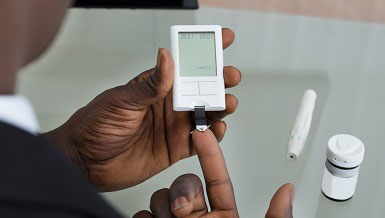What Is the Best A1c Number to Have
All About Your A1C

What has your blood sugar been up to lately? Get an A1C test to find out your average levels—important to know if you're at risk for prediabetes or type 2 diabetes, or if you're managing diabetes.
The A1C test—also known as the hemoglobin A1C or HbA1c test—is a simple blood test that measures your average blood sugar levels over the past 3 months. It's one of the commonly used tests to diagnose prediabetes and diabetes, and is also the main test to help you and your health care team manage your diabetes. Higher A1C levels are linked to diabetes complications, so reaching and maintaining your individual A1C goal is really important if you have diabetes.
What Does the A1C Test Measure?
When sugar enters your bloodstream, it attaches to hemoglobin, a protein in your red blood cells. Everybody has some sugar attached to their hemoglobin, but people with higher blood sugar levels have more. The A1C test measures the percentage of your red blood cells that have sugar-coated hemoglobin.
Who Should Get an A1C Test, and When?
Testing for diabetes or prediabetes:
Get a baseline A1C test if you're an adult over age 45—or if you're under 45, are overweight, and have one or more risk factors for prediabetes or type 2 diabetes:
- If your result is normal but you're over 45, have risk factors, or have ever had gestational diabetes, repeat the A1C test every 3 years.
- If your result shows you have prediabetes, talk to your doctor about taking steps now to improve your health and lower your risk for type 2 diabetes. Repeat the A1C test as often as your doctor recommends, usually every 1 to 2 years.
- If you don't have symptoms but your result shows you have prediabetes or diabetes, get a second test on a different day to confirm the result.
- If your test shows you have diabetes, ask your doctor to refer you to diabetes self-management education and support services so you can have the best start in managing your diabetes.
Managing diabetes:
If you have diabetes, get an A1C test at least twice a year, more often if your medicine changes or if you have other health conditions. Talk to your doctor about how often is right for you.
How to Prepare for Your A1C Test
The test is done in a doctor's office or a lab using a sample of blood from a finger stick or from your arm. You don't need to do anything special to prepare for your A1C test. However, ask your doctor if other tests will be done at the same time and if you need to prepare for them.
Your A1C Result
Diagnosing Prediabetes or Diabetes
| Normal | Below 5.7% |
|---|---|
| Prediabetes | 5.7% to 6.4% |
| Diabetes | 6.5% or above |
A normal A1C level is below 5.7%, a level of 5.7% to 6.4% indicates prediabetes, and a level of 6.5% or more indicates diabetes. Within the 5.7% to 6.4% prediabetes range, the higher your A1C, the greater your risk is for developing type 2 diabetes.
Managing Diabetes
Your A1C result can also be reported as estimated average glucose (eAG), the same numbers (mg/dL) you're used to seeing on your blood sugar meter:
| A1C % | eAG mg/dL |
|---|---|
| 7 | 154 |
| 8 | 183 |
| 9 | 212 |
| 10 | 240 |
What Can Affect Your A1C Result?

Get your A1C tested in addition to—not instead of—regular blood sugar self-testing if you have diabetes.
Several factors can falsely increase or decrease your A1C result, including:
- Kidney failure, liver disease, or severe anemia.
- A less common type of hemoglobin that people of African, Mediterranean, or Southeast Asian descent and people with certain blood disorders (such as sickle cell anemia or thalassemia) may have.
- Certain medicines, including opioids and some HIV medications.
- Blood loss or blood transfusions.
- Early or late pregnancy.
Let your doctor know if any of these factors apply to you, and ask if you need additional tests to find out.
Your A1C Goal
The goal for most people with diabetes is 7% or less. However, your personal goal will depend on many things such as your age and any other medical conditions. Work with your doctor to set your own individual A1C goal.
Younger people have more years with diabetes ahead, so their goal may be lower to reduce the risk of complications, unless they often have hypoglycemia (low blood sugar, or a "low"). People who are older, have severe lows, or have other serious health problems may have a higher goal.
A1C: Just Part of the Toolkit
A1C is an important tool for managing diabetes, but it doesn't replace regular blood sugar testing at home. Blood sugar goes up and down throughout the day and night, which isn't captured by your A1C. Two people can have the same A1C, one with steady blood sugar levels and the other with high and low swings.
If you're reaching your A1C goal but having symptoms of highs or lows, check your blood sugar more often and at different times of day. Keep track and share the results with your doctor so you can make changes to your treatment plan if needed.
What Is the Best A1c Number to Have
Source: https://www.cdc.gov/diabetes/managing/managing-blood-sugar/a1c.html#:~:text=A%20normal%20A1C%20level%20is,for%20developing%20type%202%20diabetes.
0 Response to "What Is the Best A1c Number to Have"
Post a Comment